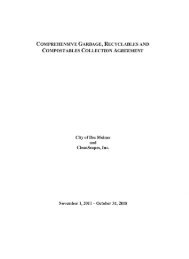CITY OF DES MOINES SHORELINE MASTER PROGRAM
CITY OF DES MOINES SHORELINE MASTER PROGRAM
CITY OF DES MOINES SHORELINE MASTER PROGRAM
Create successful ePaper yourself
Turn your PDF publications into a flip-book with our unique Google optimized e-Paper software.
Des Moines Shoreline Master Program<br />
The WRIA 9 Salmon Habitat Plan (WRIA 9, 2005) notes that the prioritization and<br />
implementation of marine nearshore projects in 2006 and beyond should consider findings from<br />
two key studies currently underway and scheduled to be completed this fall and winter:<br />
• Inventory and Assessment of Current and Historic Beach Feeding Sources/Erosion and<br />
Accretion Areas for WRIAs 8 and 9 (Johannessen and MacLennan, 2005); and<br />
• Habitat Prioritization in Marine Nearshore Areas in Support of Juvenile Salmonid<br />
Growth and Survival in WRIA 9.<br />
Both of these studies include the Puget Sound shoreline in Des Moines.<br />
A recent restoration project illustrates a type of project that could be designed and implemented<br />
in Des Moines. The following project description is summarized from the WRIA 9 website,<br />
hosted by King County Department of Natural Resources and Parks:<br />
(http://dnr.metrokc.gov/wrias/9/SRFB-seahurst-park-bulkhead-construction.htm).<br />
The Seahurst Park Bulkhead Removal and Beach Restoration Project was<br />
constructed between November 2004 and February 2005 at Seahurst Park in the<br />
City of Burien. The park provides nearly one mile of Puget Sound shoreline,<br />
habitat for rearing salmonids, including Chinook salmon. The park contained a<br />
sea-wall or bulkhead, constructed in the 1970s. Since that time, beach elevations<br />
in Seahurst Park have dropped three to four feet due to wave scouring and the<br />
disconnection of the beach from primary sediment sources. These changes had<br />
significantly degraded habitat quality for salmon and the organisms they depend<br />
on, particularly forage fish. Led by the City of Burien and supported by the<br />
WRIA 9 Forum, a $100,000 seawall removal assessment was prepared, funded by<br />
SRFB and the City of Burien. Following this feasibility study, the bulkhead<br />
removal and beach restoration project was developed. Led by the City of Burien<br />
and the U.S. Army Corps of Engineers, funding commitments included $190,500<br />
funded by SRFB, a $190,500 match by the City of Burien, and $707,000 from the<br />
U.S. Army Corps of Engineers. Implementation of the project included removal<br />
of about 1,400 feet of failing shoreline armoring and beach nourishment<br />
(importing sediment) in the southern portion of the park. Through reconnecting<br />
the sediment supply, the beach will be naturally replenished. The project goal is to<br />
restore self-sustaining nearshore habitat and ecological processes to avoid the<br />
need for on-going human intervention. A series of pre-project monitoring reports<br />
were prepared to document baseline conditions for topics such as beach<br />
topography, eelgrass, benthic invertebrates, and forage fish use. Monitoring at<br />
Seahurst Park was mostly funded by grants. The monitoring reports also<br />
established post-restoration monitoring to quantify and evaluate the benefits from<br />
the project.<br />
Before and after photos from the project (compliments of Jim Johannessen, Coastal Geologic<br />
Services):<br />
Department of Ecology approval effective November 1, 2010<br />
Adopted by City of Des Moines Ordinance No. 1502 47



